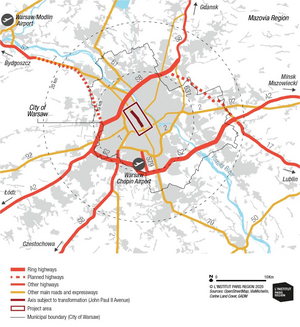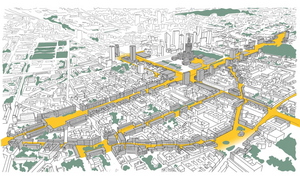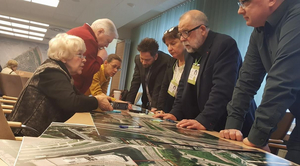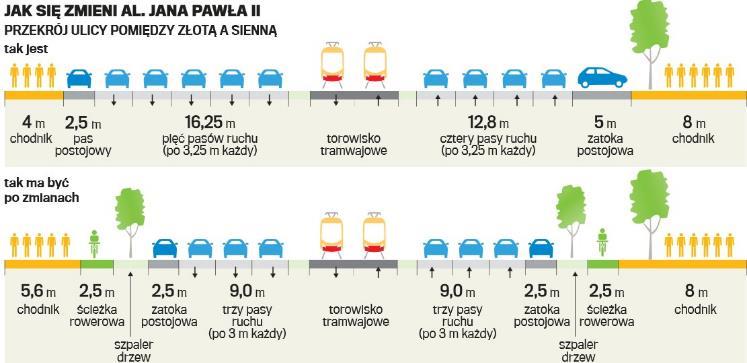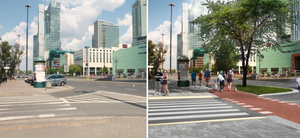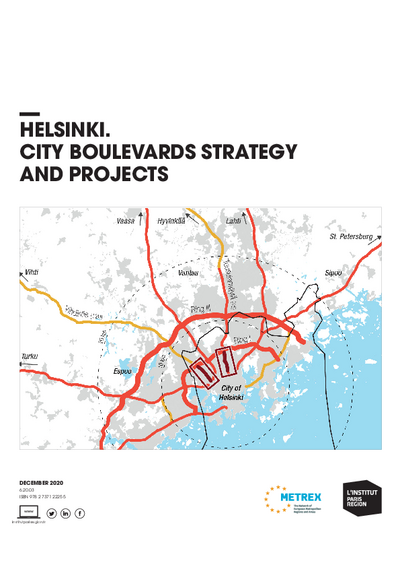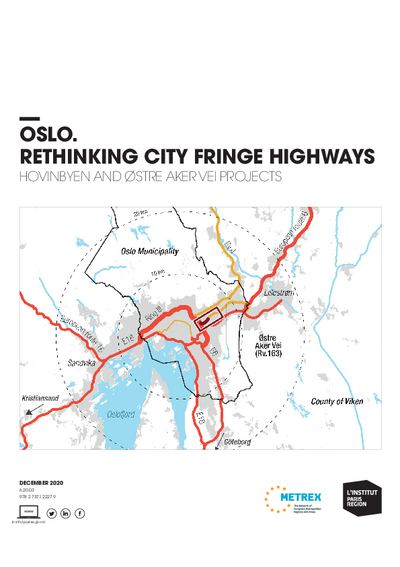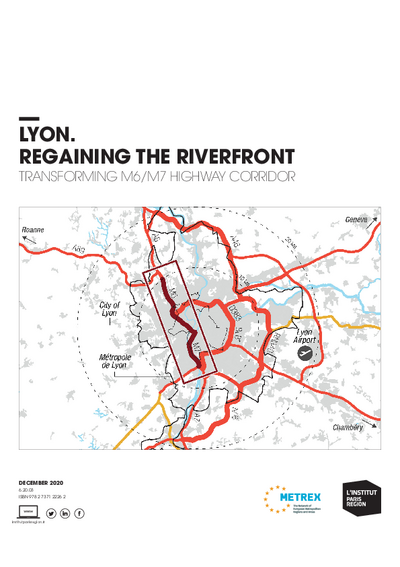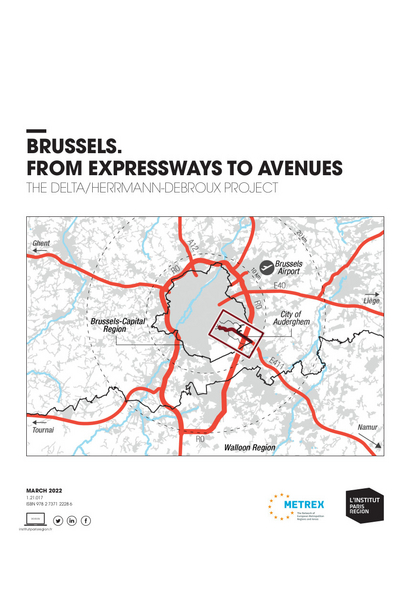Warsaw, Green Streets?
The aleja Jana Pawła II (John Paul II Avenue) crosses through the centre of Warsaw, the capital and largest city in Poland, home to 1.8 million inhabitants in an area of 517 km². The Jana Pawła II Avenue upgrade project is part of a comprehensive renovation plan for Warsaw's city centre, which aims to provide livelier, greener, and safer spaces for pedestrians and cyclists. The programme responds to the guidelines set by the Warsaw 2030 Strategy for the future development of the city and is delivered by the Public Roads Authority (ZDM) of the capital city of Warsaw.
The Jana Pawła II Avenue upgrade project is considered a flagship project for the upgrading of city centre streets./L'Institut Paris Region
The #Warsaw2030 Strategy outlines a vision and objectives for the city's development policy until 2030. It is the culmination of two years of work, which involved the local community, experts, and institutions responsible for the implementation of the strategy. The strategy is based on three main pillars:
- an open metropolis,
- active residents,
- user-friendly spaces.
Several operational objectives were set to meet the needs of people moving around the city:
- the provision of an attractive public space,
- the preservation of a clean natural environment
- the development of a convenient transport system.
The interventions on Jana Pawła II Avenue are in line with these objectives. The operational objectives are intended to be implemented through specific programmes comprising detailed executive documents. Each of them will in turn be composed of diversified projects, launched by the City of Warsaw together with its subordinate organisational units and district offices.
One of the specific initiatives developed to deliver the 2030 Strategy is the programme for the New Warsaw City Centre. The upgrading of Jana Pawła II Avenue is then considered a flagship project in terms of pedestrian and cycling infrastructure and greening, laying the foundations for other future projects.
A vision of the ambitious street improvement programme for the New Warsaw City Center. Marszałkowska Street is at centre of image and Jana Pawła II Avenue is at the back, behind the Central Station building. © City of Warsaw
The Green Streets programme put forward by the Warsaw Greenery Authority (ZZW also referred to as the Green Board of the Capital City of Warsaw) aims at transforming several dozen streets across the city. The process started by analysing the current conditions of 40 preselected streets from different parts of Warsaw and collecting information on the planned investments in the area. The next step consisted in identifying the needs of all its users through public meetings and workshops prior to defining a concept. An architect and a landscape architect were then commissioned by the ZZW to tender competition procedures on 30 selected streets in order to select teams of designers in charge of making detailed design proposals for each street.
Green Streets participative process © Warsaw Greening Authority (ZZW)
Until 2020, the 4 km-long avenue consisted of 6- to 10-lane roadway (3+3 to 5+5) separated by a median dedicated to the tramway. Its 60-metre-wide section and the tramway median separator create a large barrier between the two sides of the road. The road was a barrier for pedestrians and cyclists. In the 750m long southern section (from Koszykowa Street to the ONZ roundabout), Jana Pawła II Avenue had no pedestrian and bicycle crossings. The Jana Pawła II Avenue upgrading project is part of the comprehensive programme for the New Warsaw City Centre endorsed by the current City President. It’s the operational component of the #Warsaw2030 Strategy, which sets the main guidelines for the future development of the city.
The main initial objective of the upgrading project is to improve conditions for pedestrians and cyclists by widening pavements, creating cycling lanes and providing level crossings. However, one of the conditions is to ensure the flow of motorised traffic. The Jana Pawła II Avenue is recognised as one of the most important traffic arteries of the city, with its metropolitan character emphasized by the high-rise buildings on both sides of the avenue. In an attempt to reduce car traffic in the city centre, and as a result of the completion of new sections of the Warsaw Metro, the “ZDM” project suggests reducing the number of car lanes from 10 to 6, the lane-widths from 3.3 to 3 m, and replacing them with bikeways and sidewalks along with an additional planted strip.
Preliminary design of a cross-section of Jana Pawła II Avenue, before project (above) and after (below). Roadway is reduced to 6 lanes and the released space is used for new bikeways, larger sidewalks and greenery. The finally delivered project widened bike lanes from 2.5 m to 3 m resulting in the narrowing of sidewalks from 5.6 m to 3 m on the left (west) side and from 8 m to 4-5 m on the right (east) side. The second row of trees on the right wasn't planted (cf. photo p.29) © City of Warsaw
Before (photo) and after (artist view 2018) of Jana Pawła II Avenue with the planned removal of diagonal parking to create a bike lane © Public Roads Authority (ZDM) of Warsaw
The Jana Pawła II Avenue upgrading project aims at improving the quality of the pedestrian- and bike-friendly experience street with more space for pedestrians and bike and more road crossings. The 4 km long avenue was divided into 10 sections from Jerozolimskie Avenue to the Zgrupowania (Radosław) roundabout. A separate bike lane has been built on the western side of the road along avenue. On the eastern side, the cycle path is interrupted 200 m before the central railway station. For the rest of its length towards the south, diagonal parking spaces have been provided. Bike lanes were added along the avenue, and sidewalks were renewed and widened to three metres, with the removal of architectural barriers such as railings. Street furniture such as benches and litter bins were provided to enhance the pedestrian space.
Three at-grade pedestrian and/or bicycle crossings were implemented:
- One crossing in front of the Central Railway Station north of the Czterdziestolatka roundabout to provide direct access to the tram stops
- One crossing under the street flyover south of Czterdziestolatka roundabout at Nowogrodzka Street
- One crossing on the western side of the Czterdziestolatka roundabout, providing a continuation of the bicycle path.
The new pedestrian and bicycle crossing under the flyover at Nowogrodzka Street delivered in 2020 © Mirosław Kaźmierczak / Public Roads Authority (ZDM) of Warsaw
Initially, the plan in the Warsaw Greenery Authority's concept was to demolish the four-lane viaduct over Czterdziestolatka roundabout. However due to its high cost, the authorities and urban design team suggested to transform the flyover into a double linear urban park separated by the tramway line at ground level. In the end, the idea of a linear park had no impact on the project implemented in 2020. However, the idea remains and may be brought up again in the future.
Vision for a linear park on the viaduct of Jana Pawła II Avenue, as part of the Green Streets programme © Greening Authority of Warsaw (ZZW)
Warsaw’s recent experience in humanizing urban roads designed as highways, greening streets and giving more room for pedestrians and bikes is most interesting for all cities who wish to redesign highways to meet both citizens’ aspirations and climate requirements. In this perspective, the Jana Pawła II Avenue flagship upgrading project realised in the framework of the programme for New Warsaw City Centre is stimulating to observe and can inspire other cities. Today, the city is aiming for a more balanced approach between motorised and non-motorised modes of transportation. It is engaging in a new city-wide street greening approach framed by the New Warsaw City Centre and the Green Streets programmes, both imbedded in the City Strategy2030.
This study is linked to the following theme :
Urban planning
